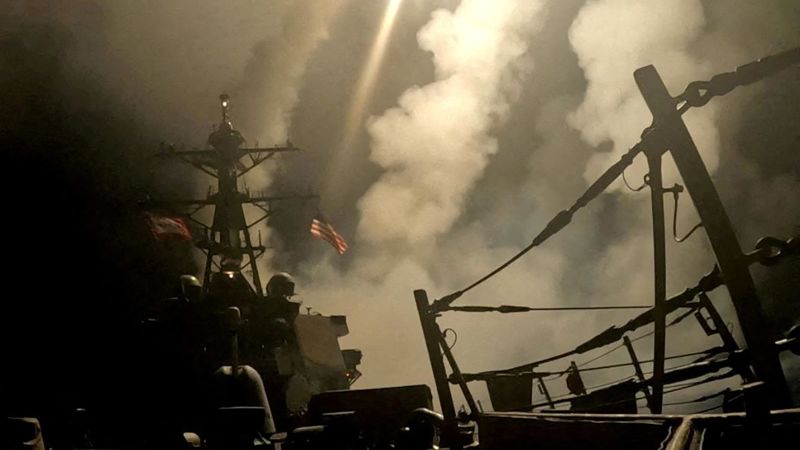On a pivotal Tuesday, President Donald Trump made a significant announcement regarding the U.S. military’s operations in Yemen, declaring an end to airstrikes against the Iran-backed Houthi rebel group. This decision came directly on the heels of the Houthis communicating their desire to disengage from hostilities, stating they “don’t want to fight anymore.” The announcement was made in the Oval Office, a formal setting where Trump was accompanied by Canadian Prime Minister Mark Carney. He noted the military campaign against the Houthis had been in response to their aggressive actions threatening shipping lanes in the Red Sea and Israel, which escalated tensions in the region.
During his remarks, Trump emphasized the Houthis’ willingness to cease their attacks, saying, “They have capitulated but more importantly, we will take their word…they say they will not be blowing up ships anymore.” This statement highlights an apparent shift in diplomatic relations between the United States and the rebel group. In light of this development, a U.S. defense official confirmed that military personnel were instructed to halt operations against the Houthis, which had been in place since mid-March.
The situation in Yemen becomes more intricate with Israel’s military actions. Recent weeks saw Israel striking targets linked to the Houthis after they launched a ballistic missile strike on key infrastructure, including Israel’s main airport, Ben Gurion International Airport. This incident heightened tensions and compelled a response from both Washington and Jerusalem, which had been monitoring the Houthi threat closely.
Trump’s declaration of cessation came as a result of intensified diplomatic interactions involving the United States, Oman, and the Houthis. Sources indicate that this understanding intends to establish momentum for ongoing discussions surrounding Iran’s nuclear program, suggesting that the situation in Yemen has broader implications for U.S. foreign policy in the region. The next round of nuclear talks between the U.S. and Iran, however, remains to be scheduled, adding an element of uncertainty to the diplomatic landscape.
In his Oval Office address, Trump directed his Secretary of State and National Security Adviser, Marco Rubio, to ensure that the broader implications of this decision were communicated widely. Rubio described the ceasefire arrangement as “an important development,” focusing on the need to maintain open shipping lanes and curb the threats posed by well-armed Houthi groups.
The U.S. envoy for Iran negotiations, Steve Witkoff, played an instrumental role in negotiating the ceasefire with the Houthis over the preceding week, with Oman serving as a mediator, a role they have historically fulfilled in U.S.-Houthi relations. The withdrawal of U.S. military strikes is anticipated to serve as leverage in the complex negotiations regarding Iran’s nuclear program, according to individuals familiar with the process.
The ceasefire talks were initially ignited by a provocative statement from Secretary of Defense Pete Hegseth, indicating that Iran’s support for the Houthis could bear consequences. This context of U.S. military operations against the Houthis has faced challenges, particularly as the militants have proved to be resilient in their capabilities, undermining the effectiveness of U.S. airstrikes and straining military resources.
Moreover, the dynamics of the U.S.-Houthi ceasefire raise questions about the ongoing conflict with Israel, where mutual hostilities have intensified. While the Houthis have consistently launched attacks against Israel often intercepted by their defense systems, the evolving U.S. stance complicates the military calculus for Israel, which has vowed to respond decisively to Houthi aggression.
Israeli Prime Minister Benjamin Netanyahu has previously asserted that such aggression would not go unanswered, foreshadowing further military operations as Israel continues targeting Houthi positions in Yemen. In a response to recent missile launches, Israel’s Defense Forces (IDF) conducted airstrikes aiming to neutralize threats posed by the Houthis.
As tensions escalate, Houthi leaders have promised retaliation, suggesting an increased possibility of conflict despite the U.S. ceasefire, revealing the precarious balance of power. The complexities of U.S. foreign policy decisions in the Middle East continue to unfold, as the situations in Yemen, Israel, and Iran remain intertwined, underscoring a fraught geopolitical landscape.
The U.S.-Houthi ceasefire and its ramifications reflect broader implications for regional security and diplomatic efforts, revealing the intricate interdependencies of actions taken by state and non-state actors in this multifaceted conflict. While the diplomatic channels remain open, the potential for renewed hostilities cannot be underestimated as each party reacts to the shifting dynamics on the ground. The ongoing developments will undoubtedly shape future engagements and strategies in the region as stakeholders navigate these turbulent waters.



